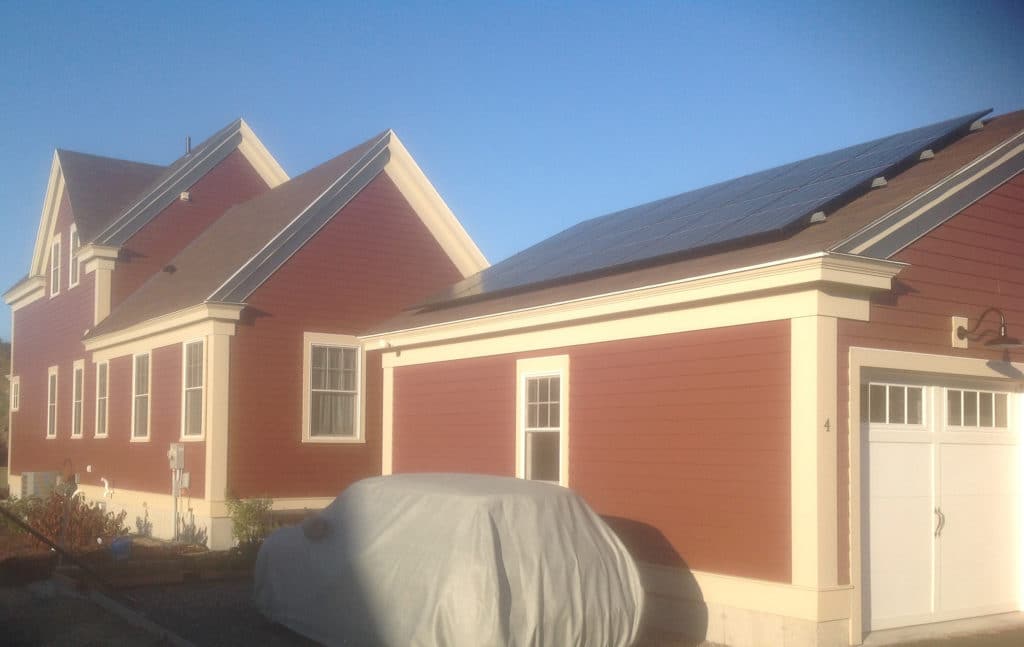
By John Grew
(In this guest blog post, John Grew shares his experiences creating an environmentally-friendly home in Scarborough.)
The first volunteer event that my wife Debbie and I participated in with Maine Audubon was the native plant sale at Gilsland Farm, a key element of the “Bringing Nature Home” initiative. As Maine Audubon members, we value the organization and what it does to protect wildlife and wildlife habitat. When we decided to build a new home, it was important to us that it be extremely energy efficient to minimize our carbon footprint and include landscaping using native plants, shrubs, and trees, to promote the health of Maine birds and insects. We likely would not have been so committed to incorporating these elements into our home design had it not been for our engagement with Maine Audubon and knowledge of its initiatives.
Our new home is in Eastern Village in Scarborough, a beautifully planned community designed to bring back the look and feel of an early twentieth-century New England village. Each home is built to high energy standards by incorporating spray foam insulation, high quality low-E windows, use of LED lighting, and HVAC systems powered by natural gas. We decided to go a step further by installing solar panels with the goal of producing at least two-thirds of our home’s electricity needs. Consistent with the decision to install solar panels, we made electricity our dominant energy source; we installed an electric heat pump water heater and electric heat pump HVAC system for both cooling and heating (a high-efficiency natural gas furnace will back up the heat pump in colder weather).
Planning the solar system was not overly complex (ReVision Energy designed and installed the system); the greatest challenge was determining the time necessary to pay back the higher up-front cost of installation. After extensive analysis, ReVision determined a conservative payback period of about 12 years, aided by a 26% federal tax credit (which unfortunately is reduced to 20% in 2021 and then expires).
After the initial six months (late May through November) our solar array has generated 2,350 kW hours and our home has consumed 635 kW hours of electricity. With a solar energy system, excess net energy production is banked each month as tracked by Central Maine Power and these banked kW hours can be saved to be used during months, like the upcoming winter ones, when energy usage exceeds energy production. Of course, we will need a year’s experience to determine what percentage of our home’s energy needs were produced by the solar system, but it appears that the original goal of two-thirds will be easily exceeded.
For our home’s landscaping, we sought professional help and hired Gnome Landscaping to design the plan. In addition to installing native plants, we also wanted to minimize the amount of yard maintenance required at our new home, since this is a retirement home.
We were very pleased with Gnome’s design and only made some minor adjustments to fit our budget. We wanted to make sure the landscaping was done correctly and that the plants would thrive or, if not, have a guarantee for their replacement. This decision was further confirmed when the CARES Act was passed to help the nation deal with the coronavirus and we decided to use our joint $2,400 federal check to pay for a major portion of the plants and planting expenses and to help Gnome, a small Maine business, keep operating during challenging times. Gnome installed the large tree, shrubs, and bushes, while we purchased and planted 10 native perennial plants from Maine Audubon including New England Aster, Columbine, Foxglove Beardtongue, and Butterfly Weed.
In making plans for our new home, we felt a responsibility to ensure that it was environmentally friendly. Once we determined that we would obtain a reasonable payback period, it was an easy decision to install solar panels. Our knowledge of Maine Audubon’s “Bringing Nature Home” initiative helped us understand the importance of native plants and including them in our landscaping plan. We hope that sharing our experience here emphasizes the importance of building an environmentally friendly new home; spotlights Maine Audubon’s efforts to encourage native planting; and provides assurance that with the right assistance it is easy to do.

